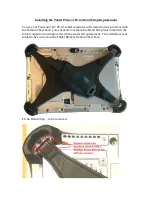
User Manual
Airbridge cBTS3612 CDMA Base Station
System Description
4 System Function
4-11
VIII. Power control
BTS performs reverse quick power control and performs reverse outer loop power
control with the coordination of BSC.
4.4 Baseband Processing
Baseband processing performs physical layer function on Um interface, processing
baseband data of all full-duplex channels in CDMA system. In the forward direction
(transmitting direction), it fulfills channel encoding, rate adaptation, interleaving,
encryption, spreading spectrum and modulation. In the reverse direction (receiving
direction), it fulfills multi-path signaling demodulation, de-interleaving, channel
decoding and information bit extraction. For different RC, baseband processing is
different. But basically it can be summarized as follows:
I. Forward channel baseband processing
In CDMA forward channel, the baseband processing of one traffic channel includes
channel encoding, rate adaptation, block interleaving, long code scrambling, power
control bit insertion, Walsh code spreading spectrum, signal modulation and
baseband filtering, as shown in Figure 4-8.
Channel
encoding
Rate
matching
Block
interleave
Long code
scrambling
Walsh code
spreading
spectrum
QPSK
modulation
Base
band
filtering
Figure 4-8
Baseband processing in forward channel
l
Channel encoding
CDMA system uses convolutional code and Turbo code for channel encoding. Its
main function is error correction. Convolutional code is used for ordinary speech
service and Turbo code for high-speed data service.
l
Rate adaptation
Since the system supports frames of different rates. The frame rates after channel
encoding are different. Rates should be adapted to ensure that the rate of frame
meets the requirement before entering the interleaver. In CDMA system, rate
adaptation is realized by symbol repetition and code puncturing.
l
Block interleaving
The purpose of interleaving is to resist fast attenuation in the radio channel
environment.















































